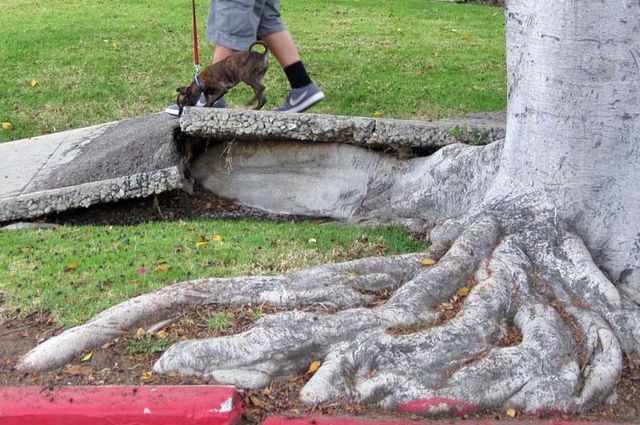
Donald Shoup is professor of urban planning in the UCLA Luskin School of Public Affairs. This op-ed is adapted from a longer article in ACCESS Magazine. This article appeared originally on Aug. 18 in the Los Angeles Times.
The city of Los Angeles has 10,750 miles of public sidewalks, and about 40 percent need some degree of repair, which the city estimates will cost at least $1.5 billion.
Why does L.A. have so many broken sidewalks? The main reason is that after accepting liability for sidewalk repairs 40 years ago, the city has failed to fulfill its commitment.
The California Streets and Highways Code places responsibility for all sidewalk repairs in the state on the owners of the abutting properties. But in 1973, L.A. received federal funds to fix sidewalks, and the City Council shifted the legal responsibility for sidewalk repairs from property owners to the city. After three years, however, the federal funding ended. Because the city was short of money, it began to make only temporary asphalt patches to cracked sidewalks or — more often — did nothing at all.
The city later tried to shift responsibility for sidewalk repairs back to property owners, but voters resisted. And a 1998 proposition to authorize $769 million in bonds for sidewalk repairs lost at the polls. The bonds would have been repaid by a citywide property tax.
Broken sidewalks make the city inaccessible for people with disabilities, especially those who are blind or use a wheelchair. Accessibility has emerged as an important legal issue because the Americans with Disabilities Act requires cities to make all public facilities, including sidewalks, accessible. Several lawsuits have been filed asserting that L.A. has failed to ensure its sidewalks are accessible. Riverside and Sacramento have already lost similar lawsuits. If L.A. also loses in court, where will it find the $1.5 billion needed for repairs?
As the City Council weighs options, here's one solution that's been successful. Some California cities, such as Pasadena and Piedmont, have adopted a repair strategy that costs them nothing: They require owners to fix their broken sidewalks when they sell their property. This strategy is called a point-of-sale program, and it has good precedents. For example, L.A. requires owners to install low-flush toilets before selling a property.
How does a point-of-sale program work? Before a property is sold, the city inspects the sidewalk fronting the property. If the inspector finds a broken sidewalk that is unsafe, the owner must fix it before the sale is final.
Point-of-sale programs have several advantages. Property owners are not required to pay or do anything until they sell a property. The sale proceeds then provide the cash to pay for repairs. Sellers fix only the sidewalk fronting their own property, so they can see exactly where their money is going. Only the owners with a broken sidewalk pay anything, and they won't pay until they sell their property.
Sidewalk repairs improve a property's curb appeal and thus increase both its sale value and the value of the neighborhood. If prospective buyers stumble over a broken sidewalk on the way to view a property, they may see that the city has neglected its public infrastructure, and turn to other cities. After all, if a city is not maintaining the sidewalks we can see, what is it doing for other infrastructure we can't see, such as water mains?
Data from the county assessor show that half of all properties in L.A. are sold at least once every 12 years. This turnover rate is similar throughout the city, so a point-of-sale program will improve the sidewalks at roughly the same rate everywhere. Because many who sell their property leave the city, the pay-on-exit policy will leave the city in better shape at no cost to everyone who remains.
Such a program will not shift the responsibility for all sidewalk repairs from the city back to property owners. Nor is it all that L.A. can do. The city can also offer to repair sidewalks at any time and delay the payment until sale. The city will, in effect, lend owners the money to pay for sidewalk repairs for as long as they continue to own the property. If it has the money, the city can also offer to share the cost of sidewalk repairs in a 50-50 plan. Nevertheless, adopting a point-of-sale program is the very least the city should do during these cash-strapped times.
A better world often arrives in small steps. With a point-of-sale program, all property owners will do their part, sooner or later. Walkable, accessible cities need good sidewalks, and a point-of-sale program will help put Los Angeles back on its feet.





